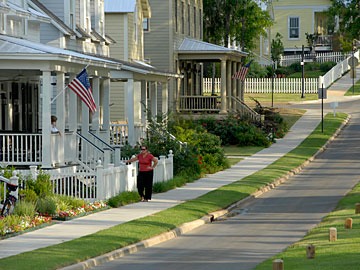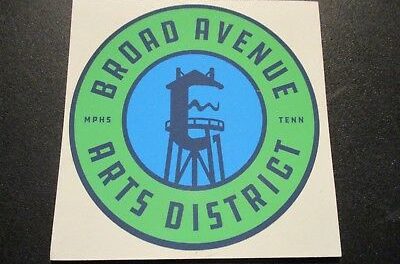From Better Cities and Towns:
By Steve Mouzon, Better! Cities & Towns

Walk Appeal promises to be a major new tool for understanding and building walkable places, and it explains several things that were heretofore either contradictory or mysterious. It begins with the assertion that the quarter-mile radius (or 5-minute walk,) which has been held up for a century as the distance Americans will walk before driving, is actually a myth.
Both images below are at the same scale, and the yellow dashed line is a quarter-mile radius. On the left is a power center. As we all know, if you’re at Best Buy and need to pick something up at Old Navy, there’s no way you’re walking from one store to another. Instead, you get in your car and drive as close as possible to the Old Navy front door. You’ll even wait for a parking space to open up instead of driving to an open space just a few spaces away… not because you’re lazy, but because it’s such a terrible walking experience.
The image on the right is Rome. The circles are centered on the Piazza del Popolo (North is to the left) and the Green radius goes through the Vittorio Emanuele on the right. People regularly walk that far and then keep on walking without ever thinking of driving.

The London standard – 2 miles

Like Rome, the world’s great cities have streets that are so good that you’ll happily walk for miles. For convenience, I’ve set a two-mile radius for the London Standard, which was so named because I presented it for the first time in London. But it could just as easily have been the Paris Standard, the Florence Standard, or… you get the idea. Europeans are reputed to walk much further than Americans, and for this reason: their streets have much better Walk Appeal. Put a Parisian accustomed to walking five miles or more per day on a suburban American cul-de-sac, and they wouldn’t walk much, either!
The T5 standard – 3/4 mile

People will walk about 3/4 of a mile on a good American Main Street. Or to be more precise, this is Transect Zone T5. Good T5 streets pull buildings right up to the sidewalk, and most of the buildings are fairly narrow because real estate is usually expensive in T5. Narrow storefronts change the walkers’ view frequently, which is more entertaining than long blank walls or long stretches of the same building. New Urbanists from Australia have for years been advocating for a “elongated pedestrian shed” along Main Streets or High Streets. Walk Appeal shows precisely why they’e been right all this time.
The T4 standard – 1/4 mile

A good street in a traditional neighborhood is where the 1/4-mile walking radius is actually accurate. The buildings aren’t right up on the sidewalk like they are in T5, so it takes a few more seconds of walking for your view to change substantially. Fences, hedges, and frontage walls all increase Walk Appeal in T4 because they’re right beside the sidewalk, where the view changes fastest. They also make people feel more comfortable sitting on the porches, so they’re more likely to get acquainted with people walking by, as we discussed here.
The T3 standard – 1/10 mile

Suburban streets (T3) allow houses to pull further away from the sidewalk, so your view changes slower. This is compounded by the fact that the lots are larger, so it takes longer to get from one house to the next. Hedges and especially fences are less frequent in T3 (I had to hunt awhile for this suburban image, with both fence and hedge,) and frontage walls are almost nonexistent. The walking distance, therefore, drops to 1/10 of a mile in T3.
Suburban streets have their proper place in traditional neighborhoods, but the problem is that we’ve been building entire subdivisions full of it, with little else. At an average walk of 1/10 mile, two blocks of T3 is more than enough to completely eat up a walk. So T3 is fine… in small doses, and near the edges of a neighborhood. But build too much, and people simply won’t walk there.
The subdivision standard – 250 feet

It’s possible, as noted above, to build entire subdivisions to the T3 standard, but most of them aren’t even that good. Instead, typical subdivisions have for decades sited houses even further from the street, with no fences or hedges at all. Some don’t even have sidewalks, a problem compounded by the wider and therefore faster streets. In these places, people are doing well to walk just 250 feet. In other words, you’re likely to walk only far enough to see four or five neighbors on either side of you. Everyone else in the place isn’t really your neighbor because you don’t even know them. Instead of calling them neighbors, we should instead say “they’re my subdivision cohabitators.”
The power center standard – 100 feet

We saw earlier how people won’t walk across a sea of parking to get to another store because the walking experience is simply too dreadful. This is exacerbated by the fact that a sea of parking is a heat island, capturing and storing the sun’s heat in all that dark asphalt, raising the temperature of the air above it by dozens of degrees in summertime. A sea of parking is also a huge stormwater runoff problem, and is most often solved by building really ugly stormwater retention pits nearby. If you don’t know what they are, a retention pit is a depression several feed deep in the ground, usually surrounded by an ugly chain-link fence, where all the styrofoam cups, packing peanuts, and plastic wrapping collects after a rain.
The parking-backed standard – 25 feet???

The worst sidewalk you could possibly choose to walk on is one with an arterial thoroughfare on one side and a parking lot on the other. I use a Walk Appeal distance of 25 feet, but in reality, you’re unlikely to ever walk in a place like this unless your car breaks down. Not only does it terminally bore you and leave you constantly awash in a sea of car exhaust fumes and sweating uncontrollably from the heat in summer, but it also is an incredibly dangerous place to walk. So people don’t.

So those are the basic settings of Walk Appeal… but that’s only the beginning. In the next few days, we’ll look at some things we can measure that determine which Walk Appeal setting a particular streetscape achieves. After that, we’ll look at how Walk Appeal can actually predict the viability of walkable neighborhood businesses… and the amazing differences that a few Walk Appeal streetscape repairs can make in order to cast a broader net for walking customers. Walk Appeal just might end up being one of the best economic development tools for walkable places… keep reading and see what you think.
Steve Mouzon is principal of Mouzon Design, an architecture and urban design firm, based in Miami Beach, Florida, and author of The Original Green, book and blog.




I don’t think we have much T-4 and T-5 in Memphis. I have always struggled with the metrics of T-3 and T-4 in Memphis as you have to calibrate the transect for each City. Judging by the illustrations in this article, I would say Midtown is T-3 even though the lots are much narrower and smaller than most residential areas of Memphis and there is more mixture of housing types. It is mainly single family though and most setbacks are at least 20 feet.
Does anyone else have thoughts on this? I would love to see us calibrate a transect to fit current Memphis and what we would like to see in the future. Then we could use the UDC as a tool to implement appropriate development in the right location.